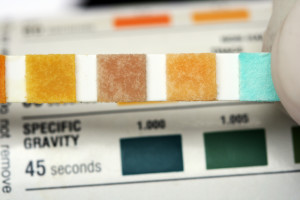Specific gravity as a monitoring tool in heat stress management.
- By Ross Di Corleto
- 06/04/2014
- No Comments
Hydration and fluid levels play a major role in the management of heat related illnesses. It then follows that being able to measure the fluid level in an individual would be a useful tool when it comes to assessing heat stress. One of the classical methods employed involves the weighing before and after of an individual to determine fluid loss. Effective but not always easily done and it does require recording of information during the day to allow for adjustments in relation to weight losses other than via fluid. More recently the use of urine specific gravity (SG) measurements have become a popular method for assessing hydration levels. So the questions here are, is it accurate and how effective is it as a tool in the quest to master heat stress?
One of the first things that needs to be understood is that water loss and replacement in the body is a complex mechanism and it is unlikely that any one method will be accurate in all aspects. Armstrong (2007) goes as far as saying that no methodology accurately represents total body water loss during day to day activities.
However there are a number of bodies of work that do acknowledge that specific gravity can be very useful. Specific gravity is basically a measure of the amount of dissolved solids in a fluid relative to distilled water.
The methodology is relatively simple. A small urine sample provide by the subject is tested using a refractometer. This instrument measures the amount the fluid bends the light as it passes through the liquid. Hence, the SG of water is 1.000 and as the fluid contains more dissolved solids this number increases. There are also urine dip sticks which are becoming more popular in industry particularly for self-testing of SG. and can be a very powerful education tool. It is a relatively safe and easy to use test and very portable.
Below is a table adapted from a paper by Casa (2000) which gives some guideline levels of S.G. and the associated percentage loss in body fluid. Current research tends to indicates that a urine SG of 1.020 is the most appropriate limit value for the demarcation of dehydration. The US National Athletic Trainers Association (NATA) has indicated that “fluid replacement should approximate sweat and urine losses, and at least maintain hydration at less than 2% body weight reduction.”
|
Body Weight Loss (%) |
Urine Specific Gravity |
|
| Well Hydrated |
<1 |
1.010 |
| Minimal dehydration |
1 – 3 |
1.010 – 1.020 |
| Significant dehydration |
3 – 5 |
1.021 – 1.030 |
| Severe dehydration |
> 5 |
> 1.030 |
When using this approach it is also important to note that there is a margin of error that needs to be considered. An example is where large volumes of water are consumed by a dehydrated individual in a very short period. This can result in the kidneys producing a large volume of dilute urine before the actual body balance is achieved. This can result in a low SG urine which is also pale in colour, providing a false indication.
BOTTOM LINE
Measuring the specific gravity of urine is a useful tool in the management of body fluid level and heat stress but it does have limitations.
KEY POINTS
- Water loss and replacement in the body is a complex mechanism and it is unlikely that any one method will be accurate in all aspects.
- Urine specific gravity is a relatively safe, easy to use test with acceptable accuracy and very portable.
- A good training tool to raise employees awareness of their personal fluid management.
- Need to be conscious of potential inaccuracies in some circumstances.
USEFUL REFERENCES
Casa DJ, Armstrong LE, Hillman SK, Montain SJ, Reiff RV, Rich BS, Roberts WO & Stone JA (2000). National athletic trainers’ association position statement: Fluid replacement for athletes. J Athl Train, 35(2): pp 212-224.
Cheuvront, SN & Sawka, MN (2005). Hydration assessment of athletes. Sports Science Exchange, 18(2).
Nevola, VR, Staerck, J, Harrison, M., (2005). Commander’s Guide: Drinking for optimal performance during military operations in the heat. Defence Evaluation and Research Agency Centre for Human Sciences, Farnborough, DERA/CHS/PP5/CR980062/1.0.
Sawka MN, Burke LM, Eichner ER, Maughan RJ, Montain SJ & Stachenfeld NS (2007). American College of Sports Medicine position stand. Exercise and fluid replacement. Med Sci Sports Exerc, 39(2): pp 377-390.

 Copyright © 2025
Copyright © 2025
Leave a Reply